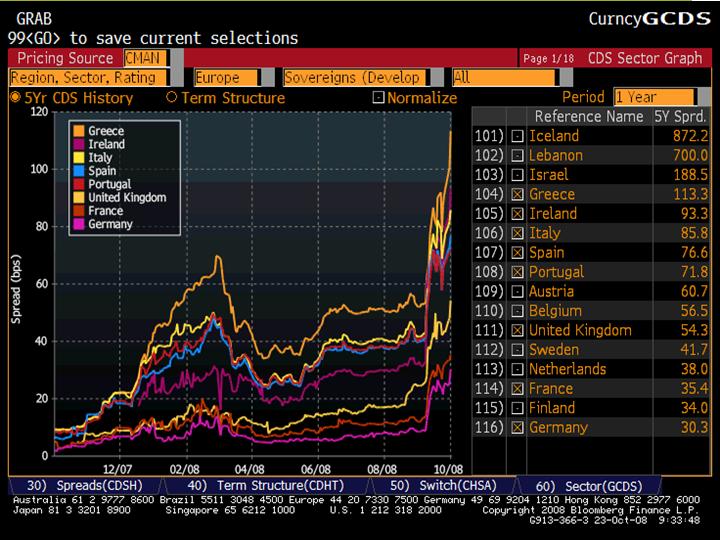What’s the risk of governments defaulting?
The vast sums of money being thrown by governments at banks right now have clear implications for developed countries’ credit worthiness. Meanwhile, emerging market governments are facing a crisis of their own. I thought it would be useful to have a look at which countries the bond markets say are at greatest risk of default, both developed and developing.
The attached chart from Bloomberg tracks the 5 year CDS on a handful of developed European countries over the past year, where 5 year CDS is the annual cost of insuring an entity’s debt for five years. So a price of 0.5% means it costs $5000 to insure $1m of debt for a year. As you’d expect, sovereign default risk has risen sharply since September. The risk of the UK government defaulting is about the same as the risk of the Belgium government defaulting, and Belgium isn’t AAA rated – it’s actually rated AA+ by S&P and Aa1 by Moody’s (which is itself a bit generous).
Emerging markets held up bafflingly well until September, but are about to experience a crisis. Jim first warned about emerging market bonds on this blog two years ago (see here), and most recently commented on the asset class in February this year (see here). As this chart shows, South America is in trouble now, and Argentina is on the brink of default, while Venezuela and Ecuador are also distressed.
The rate of deterioration in Eastern Europe is also alarming. Hungary raised interest rates by 3% yesterday to try to stop its currency collapsing (once a country’s currency starts collapsing, then its euro, dollar and yen denominated debt becomes crippling). Today, Belarus has joined Hungary, Ukraine, Iceland and Pakistan in requesting help from the IMF. Russia is in a mess too, with spreads touching 1000bps over Treasuries yesterday after the Bank of Moscow said Russian companies may default on up to a third of all local currency debt.
As recently as July this year, US BBB corporate bond spreads were in line with junk rated emerging market sovereign bonds. This was plain wrong – historically, sovereign defaults have coincided with global economic slowdown, but the substantial risk of default wasn’t being priced in. At the end of yesterday, junk rated emerging market sovereign bonds were trading at a more reasonable 968bps over treasuries, versus 657 bps for US BBB corporates. Emerging market bonds are better value now, but similarly rated high yield corporate bonds still look more attractive. And you have to wonder – while the IMF can help a few governments, how is it going to be able to afford to bail out a whole string of emerging market countries, not to mention the odd developed country?
The value of investments will fluctuate, which will cause prices to fall as well as rise and you may not get back the original amount you invested. Past performance is not a guide to future performance.


18 years of comment
Discover historical blogs from our extensive archive with our Blast from the past feature. View the most popular blogs posted this month - 5, 10 or 15 years ago!


Bond Vigilantes
Get Bond Vigilantes updates straight to your inbox








